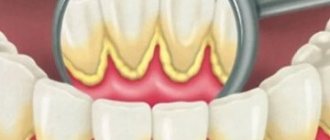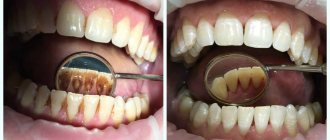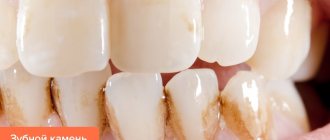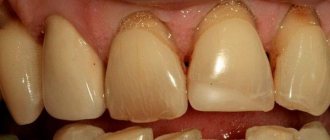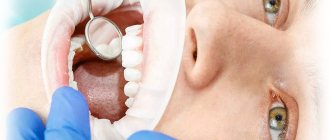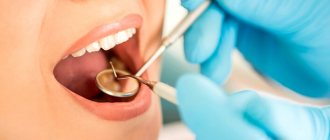Tartar formation and complications of this condition are one of the most common reasons for visiting a dentist. But not everyone knows that the appearance of this unaesthetic plaque can be prevented, and that prolonged absence of treatment for already formed stone can lead to tooth loss.
Experts diagnose almost all people with tartar, the treatment of which, as a rule, is quite expensive. To understand how you can avoid this problem, you need to understand what tartar is and how you can prevent its occurrence.
What is tartar
Tartar is hardened soft plaque. When brushing teeth incorrectly or poorly, a soft mass consisting of fragments of the mucosal epithelium, food particles and colonies of bacteria accumulates on their surface and in the interdental spaces. Under the influence of saliva and substances produced by bacteria, the mass gradually hardens, turning into tartar. Hard deposits may be observed on the back surfaces of teeth and between teeth, in which case they are classified as supragingival calculus. Gradually, under the influence of gravity and chewing movements, the stones move under the mucous membrane of the gums and are classified as subgingival.
Ultrasound is a modern way to combat tartar
Preventive cleaning of teeth from stone with ultrasound has long been a mandatory procedure in civilized countries. In our country, there is no such practice yet, so patients are more negligent about their health and most often turn to the dentist when there are obvious health problems.
The procedure for cleaning teeth with an ultrasonic scaler in dentistry is carried out by a hygienist or periodontist. The specialist assesses the condition of the teeth and gums, excludes contraindications, selects the necessary attachment for the device and begins treatment.
In case of increased sensitivity of the enamel and deep cleaning of the subgingival area, the doctor may use local anesthesia - this will make the patient more comfortable during the procedure.
Under the influence of high-frequency ultrasonic vibrations, any dental deposits are destroyed, and pathogenic bacteria are destroyed from the surface of the teeth and from periodontal pockets. Ultrasonic cleaning lasts about an hour and ends with an enamel polishing procedure. You will not only see, but also feel the result: your teeth will become clean, smooth - and no hint of dark plaque.
In children, teeth cleaning from tartar and plaque with ultrasound is carried out after changing the primary bite to a permanent one and exclusively for medical reasons.
Despite the fact that ultrasonic cleaning is a safe procedure, it has a number of contraindications:
- general somatic diseases in acute form
- colds and ARVI
- infectious diseases
Ultrasound should be used with caution in patients with an artificial cardiac pacemaker.
Ultrasonic tartar removal is the most effective and fastest way to make your smile attractive again. For preventive purposes, this procedure is recommended to be carried out every six months, and for those who wear braces, even more often - once every 3 months.
In what cases does stone plaque form?
The reason for the formation of tartar is poor quality dental care, in which soft plaque is not completely removed. High mineral content causes plaque to harden. Using a too soft toothbrush, lack of attention to the interdental spaces and gum margins, irregular oral hygiene, etc. are the main sources of the problem.
But there are factors that increase the likelihood of hard deposits forming on teeth:
- diseases of the digestive system and endocrine system, in which the chemical composition of saliva changes;
- malocclusions and dental defects that form particularly difficult areas to clean;
- wearing dentures, braces, brackets, plates and other structures that make it difficult to properly clean teeth using a traditional brush and paste;
- a large amount of carbohydrate foods in the diet, which facilitates the gluing of soft plaque particles.
Cleaning teeth from stone: techniques and their effectiveness
Table of contents
- Causes of tartar formation
- Methods for removing tartar
- Stone removal technique
- Cost of teeth cleaning
- Advantages of carrying out the procedure at MEDSI
We offer all patients of the MEDSI clinic a dental tartar cleaning
.
The procedure is carried out by dentists at least once every six months
and helps
prevent the development of caries and dangerous gum pathologies
, ensure fresh breath, relieve the patient of complexes and achieve overall oral health.
Teeth cleaning from tartar is carried out in MEDSI clinics using modern safe and highly effective methods to avoid tissue injury. During a fairly simple procedure, which usually lasts no more than 40-60 minutes, patients, even with a low pain threshold and high sensitivity, do not experience significant pain or discomfort. Thanks to this, cleaning can be carried out in almost all cases.
Causes of tartar formation
In the oral cavity of each of us, 200 billion different bacteria and other microorganisms are concentrated. At the same time, not all people devote enough time and effort to hygiene. Often it is not carried out very well and not as often as required. Few people use a toothbrush or even just rinse their mouth after breakfast, lunch and dinner to remove food debris. As a result, bacteria actively multiply and settle on soft and hard tissues, in gum pockets and in the spaces between elements of the dentition.
At first, the deposits remain soft, they can still be removed at home by regularly practicing hygiene. If soft deposits are not removed in a timely manner, they will harden and turn into dense stone. It is almost impossible to get rid of it
.
It is the stone (hard plaque) that causes:
- Bad breath
- Pigmentation of the enamel (its partial or complete darkening), worsening the appearance of the oral cavity and provoking a number of complexes in a person
- Development of caries
- The occurrence of pathological processes even in the gastrointestinal tract
Important! Tartar can appear even in those people who do not neglect hygiene, regularly brush their teeth and use special floss (dental floss) or irrigators. This is due to the fact that it is almost impossible to clean narrow spaces and gum pockets efficiently.
There are certain categories of foods and drinks that provoke a fairly rapid and intense formation of dense plaque, and then stone. These include coffee and wine, as well as sweets, pastries, and other delicacies. No one is protected from the occurrence of unpleasant plaque and tartar.
For this reason, we recommend regular teeth cleaning at MEDSI.
!
Methods for removing tartar
There are several popular methods that allow you to quickly and efficiently combat deposits.
You can remove tartar:
- By mechanical cleaning.
This technique is outdated and extremely rarely used these days; it has a number of disadvantages, the main of which is
gum trauma
. The procedure involves scraping off deposits using curettes (instruments with sharp edges), which can provoke not just discomfort, but pain and inflammatory processes. It is strictly forbidden to carry out such manipulations in case of inflammatory processes and pathological conditions of soft tissues - Sandblasting (AirFlow ).
This technique is more modern.
To remove tartar from teeth, use baking soda or sodium bicarbonate. The finished mixture is supplied under fairly high pressure, which allows you to literally knock down tartar. The liquid washes it away and at the same time allows you to cool your teeth. This technique is effective in the fight not only against stone, but also against soft plaque and pigmentation. Unfortunately, it cannot cope with large deposits. In addition, sandblasting is not carried out if there is inflammation of the gums
, as it can provoke a worsening of the condition. - Ultrasound.
This method is not only
more effective, but also less traumatic
than the previous two.
This cleaning is carried out using a special scaler (tip), which oscillates at a speed of approximately 100,000,000 movements in 60 seconds and destroys the bonds between the teeth and the formations on them. Additionally, ordinary purified water or an antiseptic is used. They provide cooling to the teeth and the tip itself. In addition, water allows you to remove all particles of stone from the interdental spaces and in the periodontal pockets. Immediately after brushing your teeth, their surface loses its smoothness, so additional treatment is carried out. It consists of polishing with pastes and brushes that eliminate roughness. This additional treatment helps prevent re-formation of plaque. Ultrasonic cleaning of teeth from stone provides many opportunities to remove all soft and hard deposits. Its advantages include the ability to improve the overall health of the oral cavity. - Laser.
This method is the most gentle.
The laser acts in a targeted manner
, affecting only unwanted formations, without damaging the surface of the teeth and gums, since the special attachment simply does not come into contact with them. All deposits are crushed into very small particles and washed away with water and air. The advantages of the method also include the fact that after brushing, teeth better absorb all the nutrients contained in food and toothpastes.
Stone removal technique
The stone removal technique involves several stages:
- Injection of a local anesthetic (not in all cases, usually with increased sensitivity or large amounts of deposits). Most often, no anesthesia is required
- Removing deposits
- Cleaning with abrasive strips. They allow you to efficiently clean the spaces between your teeth. The need to use strips is due to the fact that even a thin tip cannot penetrate into tiny gaps
- Removing all remaining deposits
- Teeth polishing
- Application of protective and strengthening varnish to the enamel
- Treatment of gums with an anti-inflammatory agent (if necessary)
- Teaching the patient proper hygiene
To maintain a long-term effect after the procedure, you must:
- Refrain from consuming drinks and foods high in synthetic or natural colors (soda, red wine, tea, coffee, carrots, beets, etc.) for the next few days
- Use a toothbrush of medium hardness, which ensures high-quality hygiene but does not allow tissue injury
- Replace your toothbrush regularly (once every 3 months), regardless of the degree of contamination and condition.
- Use the paste recommended by your doctor
- Brush your teeth, use dental floss or an irrigator at least 2 times a day
- Visit your dentist at least 2 times a year for re-cleaning
Only regular and good hygiene and adherence to the simplest recommendations will allow you to maintain the ideal condition of the oral cavity.
and save on the treatment of complex pathologies.
Important! The procedure should not be delayed.
Remember that harmful bacteria actively multiply in the oral cavity, and if a stone has already appeared, you will not be able to eliminate it yourself. Even the most expensive toothpastes won't cope with hard plaque, and the best brushes won't help remove it from gum pockets and spaces between teeth.
Cost of teeth cleaning
Are you planning to use a service such as teeth cleaning to remove tartar?
The cost depends on factors such as:
- Selected method
- Basic and additional services
- Number of teeth requiring professional cleaning
You can check the exact cost with our specialists by calling +7 (495) 7-800-500.
We not only adhere to a loyal pricing policy, offering services on favorable terms, but also periodically hold various promotions and provide discounts, which allows our clients to reduce costs for an important hygiene procedure. You can check the cost of the service in advance, which will allow you to plan your expenses. Make an appointment so that your dentist can select a technique that suits the condition of your oral cavity and determine the exact price of the procedure.
Advantages of carrying out the procedure at MEDSI
Teeth cleaning from tartar in our clinics is carried out:
- Experienced dentists
with special skills and professional knowledge in the field of aesthetic dentistry, studying new technologies and improving professionalism within their specialization - Using modern and safe techniques
that have already proven themselves - Quickly and painlessly
, thanks to which our patients return to us again and again without fear or doubt - At an optimal cost, ensuring the availability of services
for all categories of our patients - After determining all indications and contraindications and a thorough examination by a specialist
- At a time convenient for the patient, without queues and unnecessary worries
, in a comfortable environment. We understand the patient's need to participate in the treatment process. Therefore, the purpose and content of each procedure are explained to him in detail, not only the final, but also intermediate results of the work are demonstrated, photographic documentation is carried out - “In 4 hands”: each doctor is assisted by an assigned assistant, which allows him to perform medical procedures quickly and accurately
Contact us if you want your smile to always be dazzling! Call +7 (495) 7-800-500 to make an appointment for consultation and for the cleaning itself.
Kinds
Plaque is divided into two categories. First, supragingival stone appears, the cause of which is poor oral hygiene. Such deposits are located above the upper edge of the gingival crest, so they are easily diagnosed during a routine examination.
The characteristic features of supragingival tartar include:
- Localization on the inner surface of the tooth, from the side of the tongue;
- White or yellowish tint;
- The consistency is hard or clay-like.
The plaque is unstable, so it can be removed mechanically without any problems.
Subgingival calculus appears as a result of the fact that supragingival plaque descends down the root of the tooth and mineralizes. It forms in the gum pocket and is diagnosed only when using special dental instruments. Such deposits are considered age-related and most often appear in people over 40 years of age. If personal hygiene rules are not followed, it can appear at any age.
Signs of tartar:
- Dense and hard consistency;
- Light brown or greenish-black tint;
- Swelling and bleeding gums.
Preventive measures
The best method of prevention is careful hygiene. Basic rules that should be followed to prevent the formation of stones and other problems with teeth are as follows:
- Teeth must be brushed after every meal;
- Before using the paste, you should use dental floss, since the brush cannot penetrate into all the spaces between the teeth;
- If you can't floss outside the home, you can chew chewing gum.
Symptoms of Tartar
The first symptoms of tartar are a change in the color of the enamel on the upper molars and lower incisors. Soft yellow or gray plaques appear. First of all, tartar forms in areas where there is no self-cleaning of the surface during the process of chewing food or rinsing: the interdental space, the inner walls of the tooth.
Primary symptoms:
- Bad breath;
- Mild itching of the gums;
- Slight bleeding.
If no measures are taken to remove plaque, it begins to mineralize, becoming harder. As a result, the gums may become inflamed and there will be severe swelling and redness. Detachment of the gingival margin is possible, which leads to the appearance of a periodontal canal.
Possible complications
Plaque is the #1 cause of gum inflammation (gingivitis and periodontitis). Therefore, in the long term, this problem can even lead to tooth loss. In addition, deposits are localized on the teeth, and the bacteria that make them up lead to the destruction of enamel, the appearance of caries and other dental diseases.
The aesthetics of a smile are also disturbed, an unpleasant and even putrid odor from the mouth occurs, which affects a person’s psychological comfort. Another consequence is disruption of the digestive tract, since plaque is bacteria and, along with food, they also enter the stomach.
What are the dangers of tartar?
In cases where tartar has already formed, treatment should be carried out immediately. Otherwise, it moves under the gums and leads to severe disorders of tissue metabolism in soft tissues.
As a result, acute or chronic gingivitis develops, the ligamentous apparatus of the tooth becomes inflamed and, as the most severe complication, periodontal disease develops - atrophy of the tissues that provide support to the tooth. As a result, a person who has developed subgingival tartar in the future faces the need to remove teeth that have lost stability and are no longer able to perform their functions.
Are there any risks?
Removing stone is a procedure that should become mandatory in the life of any person who cares about the health of their teeth. But if mandatory visits to the dental office are gradually becoming a habit for people, not much is known about stone removal.
Using a scaler is a safe procedure if the dentist knows how to use this device. The nozzle of the device constantly oscillates from top to bottom: to avoid damage to the enamel, it must be kept parallel to the tooth surface being treated.
If you have fillings, crowns or veneers, there are certain risks. A poorly placed filling can easily fall out under the influence of ultrasound; the same applies to low-quality cement used to fix crowns. You need to understand that it is poorly placed fillings that can fall out: if the filling of teeth was carried out in compliance with all standards, then ultrasound will not cause any harm.
The procedure for removing stones using ultrasound seems simple, but this is only an appearance. There may also be deposits under the gums, which require some effort to detect. Not every dentist will want to spend his time on this, since subgingival stones are not particularly visible to patients. However, it is these formations that pose the greatest danger, since they lead to the breakdown of tissue near the teeth, their loosening and subsequent loss. Subgingival deposits are largely to blame for the occurrence and development of inflammation in periodontal tissues.
Methods for treating tartar
Treating tartar on your own at home is not possible. Tartar removal is performed using practical and painless methods in the dentist’s office:
- Ultrasonic cleaning. This is the treatment of tartar with a scaler. The equipment generates low-frequency ultrasonic vibrations that destroy dental plaque. After this, the dentition is washed with a stream of water, and the enamel is ground and polished.
- Air Flow whitening system. In this case, cleaning is performed with an abrasive compound supplied under pressure through a special nozzle. The composition includes air, water and sodium carbonate. The equipment does an excellent job of cleaning the interdental space and effectively removes stubborn plaque.
- Laser cleaning. This is a non-contact technique that does not cause discomfort or pain. Tartar cleaning is performed with a directed laser beam, the remaining particles are washed out of the oral cavity with a water-air jet.
Types of plaque
- Soft. Formed on teeth during human life. It is not noticeable on the surface of the enamel and is easily removed from it using hygiene products.
- Solid. Once hardened, it is almost impossible to remove plaque from teeth at home.
- Supragingival stone. Formed from hard plaque. Outwardly it looks like a small dark-colored rim in the cervical area.
- Subgingival stone. It is formed under the gum, so it is not visually noticeable. It can only be detected using a special dental probe or an x-ray. If subgingival stone is not removed in time, gum resection may occur.
How does an irrigator help with tartar?
One of the most frequently asked questions about whether an irrigator removes tartar can be answered this way: the irrigator helps with the prevention of tartar. It can only help if deposits have just begun to form and they have not yet formed stone. Regular and thorough brushing with a toothbrush and toothpaste, flossing, and completing your oral care with a irrigator can greatly reduce the risk of tartar.
But even in this case, tartar cleaning should be completed in the dentist’s office: the doctor will grind the enamel to eliminate roughness that facilitates the formation of plaque.
Causes of congestion
- Insufficient oral hygiene, incorrectly selected hygiene products.
- Eating a lot of sweets, sticky foods, rich in light carbohydrates, and at the same time a small amount of solid foods, such as vegetables, in the diet.
- Abuse of products that have a coloring effect. Tea, coffee, cola, carbonated drinks - all this leads to the fact that the plaque turns brownish and, after hardening, spoils the smile.
- Diseases of internal organs. Patients with diseases of the gastrointestinal tract and endocrine system are prone to the formation of plaque on their teeth.
- Partial edentia, malocclusion, severe crowding of teeth.
Patients with bridge prostheses are at risk. The bridge is fixed on the supporting tooth. Food particles get trapped under the crown. In this case, cleaning plaque on teeth with conventional means is impossible. As a result, it grows, microorganisms attack the gums and supporting teeth, and it becomes mobile. If you have dentures, you should definitely visit your dentist for professional cleaning.
Prevention of tartar formation
The only reliable and effective means of prevention is control over the quality and regularity of dental and gum care.
Be sure to brush your teeth at least 2 times a day (morning and evening), ending each procedure with the use of an irrigator. This will help remove soft plaque from areas that traditional oral hygiene products cannot reach.
In addition, it is important to monitor your overall health, promptly seek bite correction and minimize the consumption of fast carbohydrates such as baked goods, sweets, etc.
More detailed information is presented in the catalog of oral irrigators.
Products that should never be used -
Before writing this article, I carefully studied various sites that write on the topic of removing dental plaque at home. As a practicing dentist, I was somewhat shocked that such articles (by all indications) were written not just by “NON-dentists”, but by people who have absolutely nothing to do with medicine, and sometimes even lack common sense and have no idea , and what exactly do they advise.
I bring to your attention a couple of recipes that you can use to remove tartar at home. After the text of each recipe, you can read its analysis - both from the point of view of medical knowledge and a school chemistry course.
Recipe No. 1 –
“You need to make an elixir from grated black radish and lemon juice. This elixir should be consumed before bed, as well as moistened with a toothbrush and brushed your teeth.”
So, comments: the radish and lemon elixir contains nothing more than acid. Previously, in dentistry (when ultrasound was not yet used to remove dental plaque), in fact, before removing dental plaque with hand instruments, strong acids were sometimes used to slightly soften the tartar. Moreover, even after partial softening with acid, it will be impossible to remove tartar with a toothbrush or household tools.
The use of acid for removing tartar was abandoned about 40 years ago for the following reasons: 1) due to the low effectiveness of this method, 2) acid washes calcium from the surface layer of enamel, contributing to its abrasion and the development of increased sensitivity to thermal irritants.
Recipe No. 2 –
“Nut broth.
It is made by boiling 35 grams of walnut branch bark for 20 minutes in about one glass of water. Next, you need to dip your toothbrush in the broth and brush your teeth for 4-5 minutes, 3 times a day.” Comments: Try moistening your toothbrush with water and brushing your teeth with it. The effect will be exactly the same.
- Firstly, you will immediately feel how poorly your teeth are cleaned of plaque if you replace toothpaste with nut broth. Accordingly, this will lead to an increase in the amount of plaque on the teeth and accelerated formation of tartar.
- Secondly, hard dental deposits (tartar) are mineralized soft plaque.
Those. they are formed from soft microbial plaque, which was not cleaned from the teeth in time, and which was saturated with calcium and phosphorus salts contained in saliva. Thus, hard plaque is a very dense formation mineralized with calcium. From the chemistry course, you can remember that in order to dissolve calcium salts, you need a very strong acid, and not a decoction of walnut bark, which has no acidity. And as for the general use of acid to remove tartar, we have already talked about this above, i.e. this is not worth using.
